Problem 4 Given: A difference amplifier shown below With a circuit parameter R1 = R3 = 5 kΩ and R2 = R4 = 200 kΩ Required: Assuming the op amp to be ideal, a) Find the voltage gain Vd/V16(10 p) b) Find the value of the differential input resistance Rid and the output resistance R0 c) If the two key resistance ratios (R2/R1) and (R4/R3) are different from each other by 2% what do you expect the common gain Acm to be? Express your answer in dB. d) Find the value of Common Mode Rejection Ratio (CMRR) of case (c). Solution:
